Porto-North-Portugal.com
The best independent guide to the Douro
Porto-North-Portugal.com
The best independent guide to the Douro
Quintas, wineries, vineyards of the Douro Valley - which to visit in 2025?
Imagine a river carving its path through mountains, its steep slopes impossibly terraced with vineyards that cling to the schistous rock. This is the Douro Valley, a landscape of breathtaking scenery and profound history, forged by nature and shaped by millennia of human toil.
The Douro is not merely a wine region; it is the world's oldest demarcated wine territory, established in 1756, and a UNESCO World Heritage site recognised for its unique cultural landscape.
At the heart of this extraordinary place lies the Quinta - the Portuguese wine estate. More than just a winery, the Quinta is the soul of the Douro, the point where dramatic scenery, deep-rooted history, exceptional wines converge.
To visit a Douro Quinta is to embark on a journey beyond simple wine tasting. It is an immersion into the very essence of the region: walking through historic vineyards, exploring ancient cellars, and savouring regional gastronomy paired with distinguished wines.
This guide will detail the finest wine estates and quintas, and is designed for wine enthusiasts seeking authentic and memorable experiences from the Douro Valley.
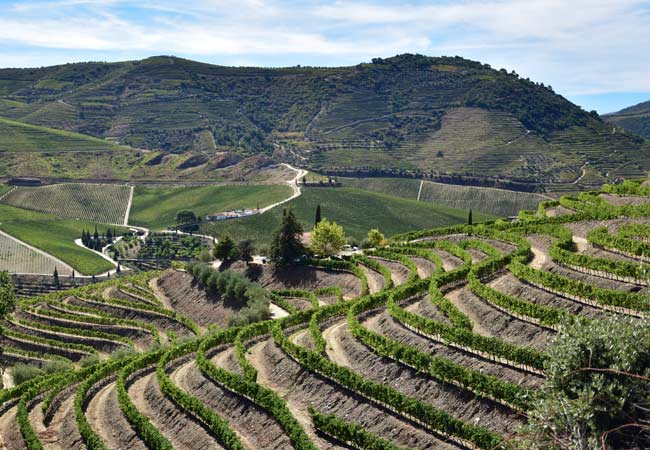
The best quintas of the Douro Valley
The following is a summary of the best quintas of the Douro Valley, a full description of each is provided later in the guide.
Quinta do Vallado (Peso da Régua)
Historic estate (1716) with striking modern architecture. Offers exceptional Aged Tawnies and acclaimed DOC wines. Features beautiful gardens, swimming pools, and diverse activities from boat tours to hiking. Combines rich heritage with contemporary design and organic viticulture. www.quintadovallado.com
Quinta Nova de Nossa Senhora do Carmo (Covas do Douro)
Historic estate (1756) with breathtaking panoramic views. Pioneer in Douro wine tourism featuring the only wine museum in the region, riverside chapel, and marked hiking trails. Known for award-winning Ports and DOCs including the prestigious Mirabilis and Aeternus ranges. www.quintanova.com
Quinta do Bomfim (Pinhão)
Symington family estate at the heart of Dow's Port. Features historic 1896 lodge, small museum, and modern lagares designed to replicate traditional foot-treading. Offers guided vineyard walks with excellent river views. Renowned for exceptional Vintage Ports. www.symington.com
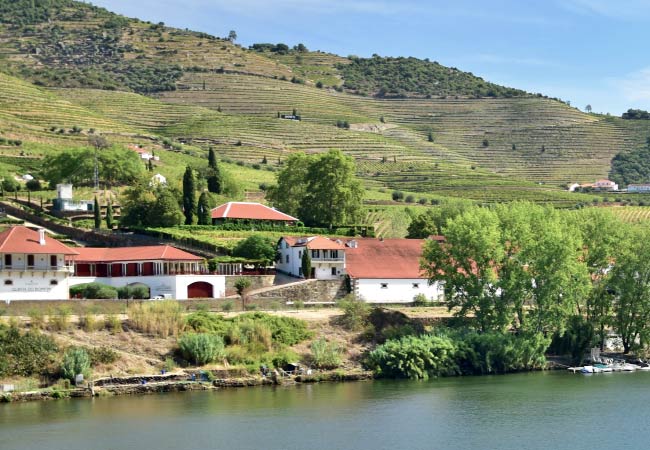
Quinta da Pacheca (Lamego)
One of the first Quintas to bottle under its own label. Famous for unique Wine Barrel accommodations nestled among vines. Notable for pioneering estate-bottled wines in the region and offering comprehensive wine tours. quintadapacheca.com
Quinta de la Rosa (Pinhão)
Family-owned riverside estate since 1906, Known for distinctive, slightly drier Port style and excellent DOC wines. Features the acclaimed "Cozinha da Clara" restaurant with stunning views. www.quintadelarosa.com
Quinta do Crasto
Ancient estate with Roman origins and spectacular high vantage point. Specializes in exceptional single-vineyard wines from century-old vines. Member of the prestigious Douro Boys group. www.quintadocrasto.pt
Quinta do Tedo (Armamar, Folgosa)
Charming 18th-century estate at the confluence of Douro and Tedo rivers. Family-owned with certified organic farming. Offers personable, educational tours in stunning ecological reserve setting. www.quintadotedo.com
Quinta das Carvalhas (Pinhão)
Iconic estate owned by Portugal's oldest wine company. Offers extraordinary 360° panoramic views from the "Casa Redonda" hilltop. Features very old vineyards, diverse tour options including a unique Vintage Tour with the estate's viticulturist, and marked walking trails.realcompanhiavelha.pt

Quinta do Noval (São Cristóvão do Douro)
Known worldwide for its premium ports, especially the iconic vintage Noval Nacional, produced from ungrafted pre-phylloxera vines. The estate dates back to 1715 and its terraced vineyards are among the most photographed in the Douro. Tours and tastings by appointment only. www.quintadonoval.com
Quinta do Seixo (Valença do Douro)
Modern winemaking facilities blend with traditional architecture at this 100-hectare estate. Features an advanced visitor center and offers detailed insights into Sandeman's port production methods. www.sandeman.com
Quinta da Roêda (Pinhão)
A historic estate known as the "jewel of the Douro," featuring some of the region's oldest vine terraces. The quinta produces exceptional vintage ports and offers traditional grape treading during harvest. croftport.com
Quinta do Panascal (Tavora)
Fonseca's flagship vineyard, known for its port wines and being one of the first quintas to open to public visits in 1992. Features an innovative audio tour through the vineyards. www.fonseca.pt
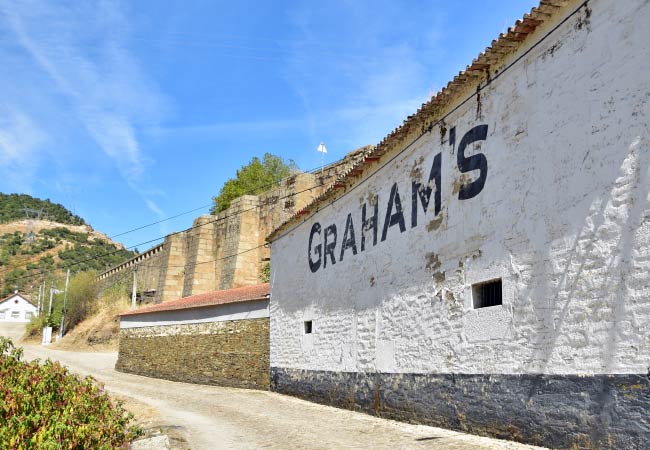
Quinta de São Luiz (Adorigo)
Home to the oldest port wine brand in the world (established 1638), known for producing premium tawny and vintage ports. kopke1638.com
Quinta Vale Dona Maria (Pinhão)
Notable for its preservation of traditional winemaking methods and production of premium Douro DOC wines. quintavaledonamaria.com
Quinta do Portal (Celeirós do Douro)
Features an architecturally significant cellar building that won the Douro Architecture Prize in 2011. Known for innovative winemaking and extensive tasting programs. quintadoportal.com
Quinta de Nápoles (Santo Adrião)
Home to Niepoort's modern winemaking facility, recognized for producing distinctive red wines and innovative port styles. www.niepoort.pt
Full details of each quintas are provided at the end of this guide.
The following interactive map shows the location of the quintas and is designed to help you plan a trip. (note: zoom in or out to see all of the points)
Legend: 1) Quinta do Vallado 2) Quinta Nova de Nossa Senhora do Carmo 3) Quinta da Pacheca 4) Quinta do Bomfim 5) Quinta de la Rosa 6) Quinta do Crasto 7) Quinta do Tedo 8) Quinta das Carvalhas 9) Quinta do Noval 10) Quinta do Seixo 11) Quinta da Roêda 12) Quinta do Panascal 13) Quinta de São Luiz 14) Quinta Vale Dona Maria 15) Quinta do Portal 16) Quinta de Nápoles
Tours of the Douro Valley
An organised tour led by an experienced guide is often the best way to get the most from the Douro region. There are many excellent tours that combine wine tasting, a boat cruise and sightseeing in a single day. Some of the best tours offered by GetYourGuide include:
What region to visit - The Douro's Sub-Regions
The Douro wine region stretches eastward from near Porto towards the Spanish border, following the Douro River and its tributaries. It is geographically and climatically diverse, traditionally divided into three sub-regions:
Baixo Corgo (Lower Corgo): The westernmost sub-region, closest to the coast and most influenced by the Atlantic. It receives the highest rainfall and has the mildest climate. Consequently, it's the most fertile area with the highest density of vineyards. Historically the first area to be extensively planted, its grapes are often used for younger, fruitier styles of Port (Ruby, basic Tawny) and lighter Douro DOC table wines. Key towns include Peso da Régua.
Cima Corgo (Upper Corgo): Considered the heartland of the Douro, this is the largest sub-region, centred around the picturesque village of Pinhão. Sheltered further inland, the climate is hotter and drier than Baixo Corgo. This area is home to many of the most famous Quintas and is renowned for producing the highest quality Port wines, particularly Vintage and aged Tawnies, as well as increasingly acclaimed Douro DOC wines.
Douro Superior (Upper Douro): Stretching eastward from the Cima Corgo to the Spanish border, this is the largest, hottest, driest, and most remote sub-region. Historically less accessible due to navigational challenges like the Valeira Gorge, it was the last to be extensively planted and vineyard area is still expanding. Due to the extreme conditions, the Cima Corgo produces grapes of excellent quality, yielding powerful, concentrated Ports and Douro DOC wines.
Underpinning the diversity of these sub-regions is defining feature: the soil. This is predominantly made up of schist, a slate-like metamorphic rock. The poor, rocky soil forces vine roots to delve deep, through fissures, in search of water and nutrients. Schist has excellent drainage but also retains moisture deep within, crucial in the dry summers. Its dark colour absorbs and reflects heat, aiding grape ripening.
The climate of the Douro region is shielded from the damp Atlantic winds by the Marão and Montemuro mountain ranges. This results in harsh extremes: scorching hot and dry summers where temperatures can exceed 40°C, and cold, sometimes severe, winters.
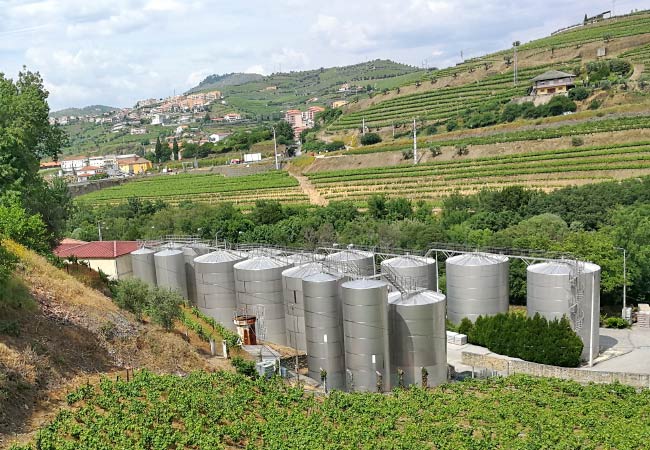
The Douro's Distinctive Wines
The Douro's unique terroir and history give rise to two distinct but related families of wine: the world-renowned fortified Port wine and the increasingly celebrated unfortified Douro DOC (Denominação de Origem Controlada) wines.
Port Wine: The region's historic ambassador, Port is defined by its fortification process. Grape spirit (brandy) is added during fermentation, halting it prematurely. This action preserves natural grape sugars, resulting in a typically sweet wine, and boosts the alcohol content, usually to around 19-22%. This process historically ensured the wine's stability for long sea voyages.
Douro DOC Wines: While Port dominated for centuries, the Douro has always produced unfortified wines. Today, the region produces roughly as much wine as Port, and these wines encompass red, white, and rosé styles:
Reds (Tinto): Often made from the same noble grape varieties used for Port, Douro reds range from medium-bodied and fruity to powerful, structured, and deeply complex wines capable of ageing.
Whites (Branco): Increasingly gaining attention, Douro whites can be wonderfully expressive, often showcasing vibrant acidity, minerality derived from the schist soils, and subtle fruit or floral notes. Styles range from crisp and unoaked to richer, barrel-fermented examples.
Rosés: Generally fresh, vibrant, and fruit-driven, ideal for warmer weather.
Moscatel do Douro: A distinct fortified wine made from the aromatic Moscatel Galego Branco grape, typically sweet with intense floral (orange blossom) and honeyed notes.
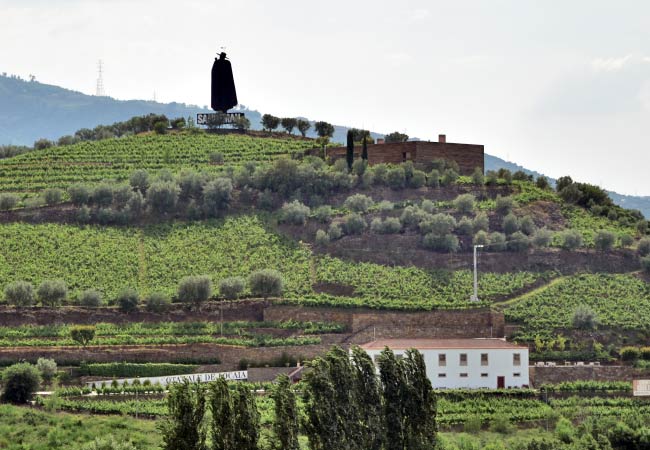
Understanding the Quinta
The term Quinta in Portugal refers to a country estate, farm, or property, often, but not exclusively, associated with wine production. While some Quintas are grand estates owned by major Port houses, Douro is also home to thousands of smaller growers farming modest holdings.
For Port wine production, the vineyards themselves (not the wineries) are subject to a classification system administered by the Instituto dos Vinhos do Douro e Porto (IVDP). This system grades vineyards from A (highest potential) down to F, based on 12 factors including altitude, aspect (slope direction), soil type (schist content favoured over granite), gradient (steeper preferred), vine age, density, and the grape varieties planted (Touriga Nacional, Touriga Franca, Tinta Roriz favoured).
This classification plays a crucial dual role. It serves as an indicator of a vineyard's potential quality for producing Port grapes, but it also functions as an economic regulator. A higher classification (e.g., A or B) allows the grower to harvest a larger quantity of grapes designated for Port wine production and generally command a higher price for those grapes.
This system historically reinforced the focus on Port. However, because the classification and its associated yield restrictions apply only to grapes destined for Port production, it creates an interesting dynamic. Quintas, particularly those with lower classifications or seeking to utilize their full vineyard potential, find it economically advantageous to channel their grapes into the production of Douro DOC wines. This economic factor contributes to the flourishing landscape of Douro DOC wines available for visitors to explore today.
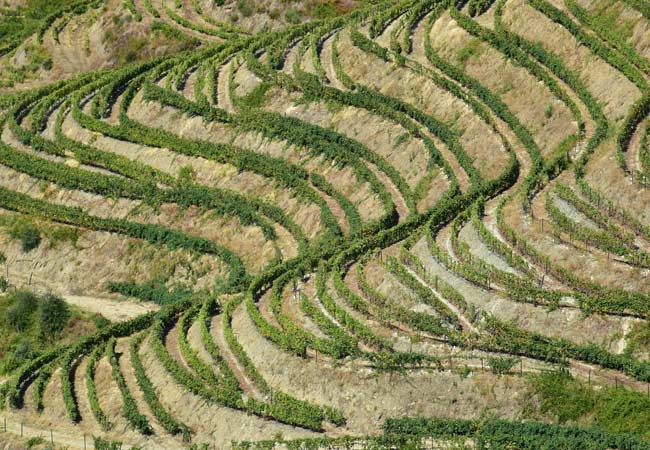
Key Grape Varieties of the Douro valley
The Douro boasts an incredible diversity of indigenous grape varieties, with over 100 authorised for use. While modern vineyards are often planted with selected varieties, older vineyards frequently contain 'field blends' - dozens of different grapes interplanted and harvested together. Despite this diversity, a handful of grapes are considered the stars:
Principal Reds: Touriga Nacional (often considered the finest, aromatic, structured), Touriga Franca (most widely planted, floral, elegant), Tinta Roriz (also known as Aragonez or Spain's Tempranillo; structure, body), Tinta Barroca (ripe fruit, softness, often on cooler slopes), Tinto Cão (structure, complexity, longevity), Sousão (deep colour, acidity), Tinta Amarela (Trincadeira).
Principal Whites: Gouveio (structure, acidity), Malvasia Fina (aromatic, delicate), Moscatel Galego (aromatic, for Moscatel do Douro), Rabigato (acidity, freshness), Viosinho (body, complexity, ageing potential), Códega do Larinho, Donzelinho Branco, Esgana Cão, Folgazão, Arinto, Cercial, Boal.
A detailed guide to the best Quintas and vineyards of the Douro
The Douro Valley is dotted with hundreds of Quintas, ranging from world-famous historic estates to tiny family farms. This section details the finest Quintas of the Douro Valley to give you a taste of everything the Douro offers.
Quinta do Vallado (Peso da Régua)
A historic cornerstone, Quinta do Vallado was established in 1716, making it one of the Douro's oldest estates. It once belonged to the legendary Dona Antónia Adelaide Ferreira and remains in the hands of her descendants today. Its prime location is near Peso da Régua, on the banks of the Corgo River, a tributary of the Douro.
Why Visit: Vallado offers a compelling blend of deep history and sleek modernity. Its state-of-the-art winery, designed by architect Francisco Vieira de Campos, is architecturally significant and highly visited. The estate features beautiful gardens, inviting swimming pools, and a commitment to organic viticulture in parts of its vineyards. Visitors can engage in various activities, including boat and jeep tours, picnics, hiking, canoeing, and cycling. The overall visitor experience is consistently highly rated.
Wine Cellar: Quinta do Vallado produces both Port wine (with particularly noted Aged Tawnies) and an extensive, highly regarded range of Douro DOC wines. Their DOC portfolio includes reds like Vallado Red, Três Melros, Douro Superior, varietals such as Sousão, Touriga Nacional, and Tinta Roriz, the flagship Reserva Field Blend, and the prestigious Adelaide. They also produce white and rosé DOC wines.
Official Website: www.quintadovallado.com
Quinta Nova de Nossa Senhora do Carmo (Covas do Douro)
The Quinta Nova de Nossa Senhora do Carmo estate has been listed since the original 1756 demarcation. Its original manor house, winery, and riverside chapel date back to 1764-65. It holds a commanding position on a hilltop within the Cima Corgo sub-region.
Why Visit: Quinta Nova is renowned for its breathtaking panoramic views over the Douro River and its meticulously terraced vineyards. It was the first Douro estate to open its doors to wine tourism and remains highly rated. Unique features include the historic buildings, a riverside chapel originally built for sailors, the Fernanda Ramos Amorim Wine Museum Centre (the only one of its kind in the Douro), beautiful grounds with a panoramic swimming pool, marked hiking trails through the estate, and unique experiences like the 'Winemaker for a Day' program. The Quinta also emphasizes sustainability.
Wine Cellar: Quinta Nova produces both Port wine (LBV and Vintage are mentioned in tasting programs) and a range of Douro DOC wines (red, white, rosé). Notable wine ranges include Quinta Nova, Mirabilis, Grainha, and the exclusive Aeternus. The estate is known for its award-winning, high-quality wines.
Official Website: www.quintanova.com
Quinta da Pacheca (Lamego)
The Quinta da Pacheca holds the distinction of being one of the first Quintas in the Douro to bottle its own DOC wines under its own label. It’s history stretches back to the 16th century, with the name "Pacheca" appearing in documents from 1738, referring to its then-owner, Da. Mariana Pacheco Pereira. A historic Pombaline demarcation stone from 1758 is preserved on the property.
Why Visit: Pacheca is famous for its highly original Wine Barrels accommodation - luxurious suites shaped like giant barrels nestled in the vineyard. Other unique offerings include the Vineyard Spa with grape-based treatments and the Atelier d'Or, an art space offering workshops like painting with wine. The estate provides beautiful views and a wide array of activities, including cooking classes and picnics. It's a very popular and award-winning wine tourism destination, which can mean it feels busy or standardized during peak times.
Wine Cellar: Quinta da Pacheca boasts a comprehensive portfolio, producing Port wines in various styles (Tawny including 10, 20, 30, 40, 50 Years Old and Colheita; Ruby Reserva; Vintage; White including 10 Years Old; and Rosé) and a wide range of Douro DOC wines (Reds including Reserva, Grande Reserva Touriga Nacional, Vinhas Velhas Reserva, Lagar Nº1; Whites including Reserva, Grande Reserva, Sauvignon Blanc; Rosé Reserva; Sparkling Brut Nature; Moscatel; and Late Harvest).
Officla website: quintadapacheca.com
Quinta do Bomfim (Pinhão, Cima Corgo)
Profile: Quinta do Bomfim is centrally located in the village of Pinhão. It has been owned and farmed by the Symington family for five generations. This Quinta is the heart of the prestigious Dow's Port house, providing the core structure and character for Dow's acclaimed Vintage Ports.
Why Visit: Offers a fascinating insight into a major Port house with deep historical roots. Key features include the impressive historic lodge built in 1896, a small museum detailing the estate's history, guided vineyard walks offering excellent views, a beautiful terrace overlooking the Douro River for tastings or picnics, and the opportunity to see modern lagares designed to replicate traditional foot-treading. Its location makes it easily accessible from the Pinhão train station. The Quinta is also a centre for the Symingtons' viticultural research, particularly concerning native grape varieties.
Wine Cellar: The primary focus is on Dow's Port, including their renowned Vintage Ports, LBV, Aged Tawnies (e.g., 30 & 40 Year Old), and the Quinta do Bomfim Single Quinta Vintage Port (bottled in non-declared years). They also produce Symington Douro DOC wines under the Vale do Bomfim label (Red and White).
Offical website: www.symington.com
Quinta de la Rosa (Pinhão, Cima Corgo)
Quinta de la Rosa enjoys a prime location on the banks of the Douro River, just a short distance (2km) from Pinhão. The estate has been in the Bergqvist family since 1906, when it was given as a christening present to Sophia Bergqvist's grandmother, Claire. Although the family had been in the Port trade since 1815 (Feueheerd shippers), they relaunched Quinta de la Rosa as an independent producer, bottling under their own label, in 1988.
Why Visit: La Rosa offers an authentic experience of staying and dining within a working family-owned Quinta. Its stunning riverside location provides exceptional views. The highly-regarded restaurant 'Cozinha da Clara' serves contemporary takes on local cuisine with Douro vistas. A more casual option, 'Tim's Terrace', offers pizza and BBQ. Unusually for many Quintas, La Rosa handles its entire production process on-site, from grape growing to bottling, offering a complete picture. Charming accommodation is integrated into the estate, and there's a swimming pool. Their Ports are known for a distinctive, slightly drier style.
Wine Cellar: Quinta de la Rosa produces a range of Ports, including Finest Reserve Ruby, Tawny (including 10 Year Old Tonel 12), LBV, Colheita, and Vintage. They also have a strong focus on Douro DOC wines, offering Estate White, Rosé, and Red, a Grande Reserva Red, and the entry-level douROSA Red. Additionally, they produce Passagem wines from their Quinta de Bandeiras property in the Douro Superior and even brew their own La Rosa Beer.
Officla website: www.quintadelarosa.com
Quinta do Crasto (Gouvinhas, Cima Corgo)
Quinta do Crasto commands a spectacular location on the Douro's right bank, between Régua and Pinhão. Its history is ancient, with the name 'Crasto' deriving from a Roman fort ('castrum') and wine production records dating back to 1615. It holds a historic Pombaline marker stone. The estate has been in the hands of the Roquette family for over a century, with Leonor and Jorge Roquette taking over in 1981 and spearheading its modern reputation for high-quality Douro DOC wines alongside Port. Quinta do Crasto is also a member of the prestigious Douro Boys group.
Why Visit: Crasto is renowned for its breathtaking, dramatic views from its high vantage point overlooking the river. Its iconic infinity pool, designed by architect Eduardo Souto de Moura, is frequently photographed and offers an unforgettable experience. The estate boasts significant plantings of very old vines (Vinhas Velhas), some over a century old, which contribute to their top wines. They have a strong focus on single vineyard expressions, particularly the acclaimed Vinha Maria Teresa and Vinha da Ponte. Quinta do Crasto demonstrates a commitment to sustainability and biodiversity, undertaking projects like genetic mapping of their old vines. The estate consistently produces wines of exceptional, internationally recognised quality.
Wine Cellar: Quinta do Crasto produces both Port wine (styles include LBV, Vintage, Colheita Tawny, Aged Tawnies - 10, 20, 30, 40 Year Old, and Finest Reserve Ruby) and a distinguished range of Douro DOC wines. The DOC range includes Crasto Red, White, and Rosé; Crasto Superior Red and White; the highly regarded Crasto Reserva Vinhas Velhas (Old Vines); single vineyard reds Vinha Maria Teresa and Vinha da Ponte; and varietal wines like Tinta Roriz and Touriga Nacional. They also produce high-quality Extra Virgin Olive Oil under the Quinta do Crasto Premium and Selection labels.
Offical website: www.quintadocrasto.pt
Quinta do Tedo (Armamar, Cima Corgo)
Quinta do Tedo is an 18th-century estate beautifully situated at the confluence of the Douro and Tedo rivers. It was purchased in 1992 and lovingly restored by Vincent Bouchard (of the Burgundian winemaking family Bouchard Père et Fils) and his Californian wife, Kay Steffey Bouchard. The Quinta operates as a 'single quinta', meaning all production comes from their own vineyards, with a strong focus on certified organic farming.
Why Visit: Tedo offers a charming, small-scale, family-owned experience in a stunning natural setting within an ecological reserve. The location at the river confluence provides exceptional views. They are known for personable and highly educational tours. The estate is Biosphere Certified, highlighting its eco-focus. Visitors can enjoy dining at the Bistro Terrace and engage in activities like hiking, kayaking, and biking. Quinta do Tedo consistently receives excellent visitor reviews.
Wine Cellar: Quinta do Tedo produces certified organic Port wines (Rosé, Tawny, Ruby, LBV, and Vintage, including a special 'Savedra' Vintage) and Douro DOC wines (Red, Rosé, Reserva Red, and Grande Reserva Savedra Red). They also produce their own Extra Virgin Olive Oil. All products are estate-grown.
Offical website: www.quintadotedo.com
Quinta das Carvalhas (Pinhão, Cima Corgo)
Quinta das Carvalhas is an iconic and visually stunning estate located on the left bank of the Douro, directly opposite the village of Pinhão. It is owned by Real Companhia Velha, Portugal's oldest wine company (founded 1756), under the stewardship of the Silva Reis family. The Quinta itself has historical references dating back to 1759.
Why Visit: Carvalhas is often considered the "image of the Douro" due to its dramatic, expansive vineyards and exceptional 360-degree panoramic views, particularly from the unique hilltop viewpoint known as the 'Casa Redonda' (Round House). The estate features significant parcels of very old vines, some nearing a century in age. It offers a diverse range of tour options, including a unique Vintage Tour personally guided by the estate's viticulturist, providing deep insights into the land, and marked walking trails for self-exploration. Carvalhas emphasizes biodiversity and sustainable agriculture. Its convenient location near Pinhão makes it easily accessible, and it's noted as a place where visitors can sometimes enjoy a tasting flight without needing a full tour reservation.
Wine Cellar: Quinta das Carvalhas produces both Port wines (including Vintage, 20 & 30 Year Old Tawny, and Reserve Ports) and a range of premium Douro DOC wines. The DOC range highlights specific grape varieties like Tinta Francisca and Touriga Nacional, alongside a White, a Reserva Red, and the top-tier Vinhas Velhas (Old Vines) red.
Offical website: realcompanhiavelha.pt
Smaller / Family-Run Options
While the large, historic Quintas offer impressive scale and facilities, the Douro Valley is also rich with smaller, often family-run estates that provide a different kind of charm and authenticity. Visiting these can offer a more intimate glimpse into the life of the region. Examples include:
Quinta de Santa Eufemia (Parada do Bispo, Baixo Corgo): Visitors praise this small winery for its relaxed, welcoming atmosphere, the warmth and knowledge of the hosts, its beautiful tree-shaded patio with lovely views, and its delicious Port wines. It represents the appeal of stepping slightly off the main tourist track for a more personal encounter. Note that smaller operations like this may have limitations, such as not being set up for international shipping.
Aneto Wines (Peso da Régua area, Baixo Corgo): A family venture started in 2001, Aneto focuses on producing high-quality, small-batch Douro DOC wines (including interesting offerings like Pinot Noir and sparkling wine) alongside Port. They have restored an old cellar and added a modern tasting room. Their connection to the highly-regarded Aneto & Table restaurant in Peso da Régua offers excellent food and wine pairing opportunities. This Quinta exemplifies a blend of modern winemaking ambition rooted in family tradition.
If you've found our content valuable, we'd welcome your support.
The digital publishing landscape has evolved significantly. As a small independent publisher, we face growing challenges. Search engines increasingly favour paid content over organic results, while AI-generated content often reproduces original work without attribution.
To support our work, please consider bookmarking this page (press Ctrl + D) for quick access. If you find an article helpful, we'd be grateful if you'd share it with friends on social media.
For specific questions, please see our Reddit community at r/LisbonPortugalTravel.
Should you notice any outdated or incorrect information, please contact us at [email protected]
Thank you for helping us continue to provide valuable content in an increasingly challenging digital environment.



















